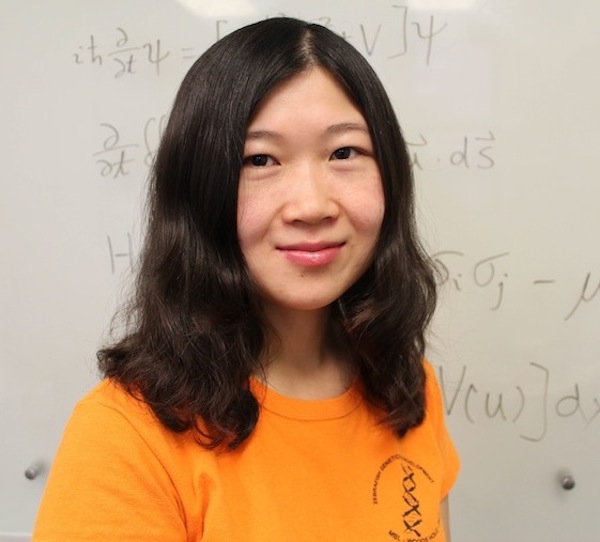Seminars 2016-2017
The Seminar Series will begin at 11:30 AM on Tuesdays unless otherwise specified. Food will be served before the seminars. Financial support for the seminars was kindly provided by the Rackham Graduate School.

|
April 17, 2018 Two-Color Irradiation for Rapid Additive Manufacturing 12:15-1:15 | FXB 1008Martin de Beer Current layerless (or continuous) methods for stereolithographic additive manufacturing, or 3D-printing, rely on a thin diffusion-controlled oxygen-inhibited dead zone to eliminate adhesion to the projection window during printing, allowing for an order of magnitude improvement in the achievable printing speeds (when compared with traditional SLA devices). In this talk, I will discuss a novel method using a two-color irradiation scheme to spatially control polymerization, generate dead zones for rapid additive manufacturing, and enable additional functionality over current continuous additive manufacturing methods. Furthermore, I will talk about some of the challenges and promises of 3D-printing in microfluidics.
|

|
April 3, 2018 Engineering the cellular microenvironment 12:15-1:15 | FXB 1008Prof. Derek HansfordThe Ohio State University In vivo, the cellular microenvironment is a combination of specific, localized stimuli of mechanical, chemical, and sometimes electrical cues that guide cellular responses and dictate their physiology. In vitro cell culture rarely captures any of this localized microenvironmental influence and as a result is often lacking in providing detailed insight into native (in vivo-like) cellular responses. With recent advances in nontraditional material micro- and nanofabrication, we are now able to control local mechanical stimuli by precise placement of structures with different mechanical and chemical properties to study their effects on cellular attachment, proliferation, differentiation, and metabolism. In this presentation, tools for controlling the cellular mechanical and chemical microenvironment will be presented, along with microfluidic tools for more precise interactions and control of cells and cellular products. Specific examples including our new technology for localized control of chemical delivery based on localized electroosmotic flow through nanofluidic membranes to individual cells (Single Cell Culture Wells, SiCCWells), tools for studying tumor cell migration based on microtopography, and enhancing implant-tissue bonding through defined microtopography will be discussed. With the combination of these techniques, we now have a wide array of parameters available to test single cell or cell cluster cultures for providing more detailed analyses of the effects of individual parameters on cell physiology, and more precise tools for analyzing patient samples.
|

|
March 6, 2018 The Revolution Will Be Compartmentalized 12:15-1:15 | FXB 1008Prof. Brian PaegelThe Scripps Research Institute The NIH Molecular Libraries Program (MLP) was founded to translate the discoveries of the Human Genome Project into therapeutics through a network of high-throughput screening (HTS) centers. A decade of discovery produced hundreds of probes — highly selective small molecules that modulate cellular function — but centralized compound screening bears the same cost and infrastructure burdens of millennial DNA sequencing centers, which has limited access to the technology and, more significantly, the rate of small molecule discovery. We are building a distributable drug discovery platform consisting of DNA-encoded combinatorial compound bead libraries and microfluidic integrated circuits that load individual compound library beads into picoliter-scale droplets of assay reagent, photochemically cleave the compound from the bead and into the droplet, incubate the dosed droplets, and sort hit-containing droplets based on biological activity for DNA amplification and sequencing. We have now synthesized various DNA-encoded compound libraries, developed droplet-scale assays for diverse targets (HIV-1 protease, ZIKV NS2B-NS3 protease, autotaxin, bacterial ribosome), and discovered new inhibitor hit structure families during library screening. The scalability of this platform will democratize drug discovery and replenish the pipeline of therapeutics, especially those targeting rapidly-evolving bacterial and viral pathogens, and neglected diseases.
|
|
|
February 20, 2018 The Most Exciting Phrase in Science: That's Funny... 12:15-1:15 | FXB 1008Priyan Weerappuli Though the pressures of professionalized academic research may lead us to feel otherwise; the pursuit of scientific understanding is rarely a linear process. Often, the most interesting questions we engage with as researchers are the byproducts of failed experiments and accidental observations. In this informal talk, I will describe two projects that are owed to such serendipitous circumstances: one leading to the development of a microfluidic system for the study of platelet activation, and another leading to the development of an artificial DNA-histone macrostructure capable of mimicking properties of neutrophil extracellular traps.
|

|
February 6, 2018 Lineage-dependent subtype specification in the type-II neuroblasts of Drosophila melanogaster 12:15-1:15 | FXB 1008Nigel Michki In order to better understand how neural circuits in the brain operate, both a 'wiring diagram' and a 'parts list' is required. This parts list specifies all of the different functional components (neuronal subtypes) that make up the circuit and is challenging to determine using microscopy alone, as different neuronal subtypes may have only subtle differences in morphology/surface markers. I here propose to use single-cell RNA-seq to investigate neuronal subtype specification in the 16 type-II neuroblast lineages of Drosophila melanogaster, chosen as a model system due to the type-II neuroblasts' striking similarity to outer radial glia-like cells in the developing human neocortex (intermediate stem cells responsible for the immense neural proliferation observed throughout gestation). We will use our scRNAseq preparation method (SELACseq) to efficiently capture and merge the rare type-II cell population with mRNA capture beads using a novel microfluidic chip that efficiently performs this merging with low sample loss. Finally we will introduce an mRNA-based 'lineage barcoding' construct into the fly genome in order to uniquely label mRNA from each of the 16 type-II neuroblast lineages, enabling us to group together mRNA from cells which belong to the same lineage and thus determine firstly which neuronal subtypes are generated within each lineage, and secondly what transcriptomic changes occur within each lineage throughout development to specify these neuronal subtypes (using replicate insects at multiple developmental time points).
|

|
February 6, 2018 Integration of Microfluidics with Mass Spectrometry for Mass-Activated Droplet Sorting 12:15-1:15 | FXB 1008Daniel Holland-Moritz The use of enzymes in the chemical industry has allowed cheaper and more efficient production of products ranging from pharmaceuticals to biofuels. Adapting these biocatalysts to perform on non-native substrates presents a challenge to researchers, who must screen through thousands of modified enzymes to identify mutations favorable to catalysis. Droplet microfluidics provides an attractive approach to this form of directed evolution, and allows the expression of millions of enzyme variants within individual picoliter to nanoliter scale droplets. To date, these large libraries have only been screened using optical readouts, which limits the range of enzyme products that can be detected. We are developing a system that overcomes this limitation by using mass spectrometry to analyze the contents of these droplets. This technique offers nanomolar limits of detection and would allow for label-free analysis of the enzyme variants, even at low levels of turnover. Analysis of droplets as small as 300pL has been achieved at up to 6 Hz, suggesting the potential to screen tens of thousands of enzyme variants and condense months of resource intensive experimentation into a single test tube and a single day.
|

|
January 23, 2018 Pressure-Actuated Microfluidic Devices Integrating Solid Phase Extraction, Fluorescent Labeling, and Microchip Electrophoresis for Pre-Term Birth Biomarker Analysis 12:15-1:15 | FXB 1008Dr. Vishal Sahore Work to be presented here was performed at the Department of Chemistry and Biochemistry, Brigham Young University, Provo, UT. We have developed the pressure-actuated integrated microfluidic devices to help diagnose the risk of a pre-term birth (PTB). The novelty of our work lies in the integration of solid phase extraction (SPE) for sample enrichment, fluorescent labeling, and elution into the injector for microchip electrophoresis (μCE) separation, on a single platform. Initially, we developed a μCE module in a three-layer poly(dimethylsiloxane) (PDMS) system. As a next step, we have developed an automated, multichannel device, integrating SPE and μCE modules, for on-chip enrichment, fluorescent labeling, elution to an injector, and μCE separation of PTB biomarkers. SPE of PTB biomarkers was performed on a reversed-phase porous polymer monolith fabricated inside the thermoplastic layer, whereas hydrodynamic control operated through peristaltic pumps and pneumatic valves in the PDMS layer. Initially, we determined μCE conditions for two PTB biomarkers, ferritin (Fer) and corticotropin-releasing factor (CRF). We used these integrated microfluidic devices to pre-concentrate and purify off-chip-labeled Fer and CRF in an automated fashion. Finally, we performed a fully automated on-chip analysis of unlabeled PTB biomarkers, involving SPE, labeling, and μCE separation with 1 h total analysis time. These integrated systems have strong potential to be combined with upstream immune-affinity extraction, offering a compact sample-to-answer biomarker analysis platform.
|

|
January 9, 2018 Single cell approaches to undertanding the nervous system 11:30-12:30 | Pierpont Commons East RoomProf. Dawen Cai The brain functions similarly to an electronic system that is composed of many parts (neurons) of distinct properties that are wired to each other. Understanding the molecular and physiological properties of individual neurons and the connection pattern between them has been a central goal of neuroscience. Over the years, we have been developing genetics, microscopy and computational tools to label, image and reconstruct individual neurons and their connections in the brain. More recently, we have developed a high-throughput microfluidics based single cell mRNA sequencing platform to efficiently recover individual neurons to identify distinct neuronal subtypes by transcriptomic profiling. In the future, we aim to combine these technologies to reverse engineer the "transcriptomic connectome" of a brain circuit, in which the molecular properties of individual parts (neurons) and their wiring diagram are unambiguously profiled.
|

|
November 28, 2017 Incoherent inputs enhance robustness of biological oscillators 11:30-12:30 | Dow 2150Prof. Qiong Yang Robustness is a critical ability of biological oscillators to function in environmental perturbations. Although central architectures that support robust oscillations have been extensively studied, networks containing the same core vary drastically in their potential to oscillate, and it remains elusive what peripheral modifications to the core contribute to the large variation. We computationally generate a complete atlas of two- and three-node oscillators, to systematically analyze the association between network structures and robustness. We found that, while certain core topologies are essential for producing a robust oscillator, local structures can substantially modulate the degree of the robustness. Most strikingly, local nodes receiving incoherent (positive plus negative) or coherent (both positive or both negative) inputs promote or attenuate the overall network robustness significantly in an additive manner. These motifs are validated in larger-scale networks. Additionally, we found that incoherent inputs are enriched in almost all known natural and synthetic oscillators, suggesting that incoherent inputs may be a generalizable design principle that promotes oscillatory robustness. Our findings underscore the importance of local modifications besides robust cores, which explain why auxiliary structures not required for oscillation are evolutionarily conserved, and further suggest simple ways to evolve or design robust oscillators.
Experimentally, we develop an artificial cell-cycle system in microfluidics to quantitatively investigate how network structures are linked to the essential clock functions. We also investigate how multiple clocks coordinate in essential developmental processes of early zebrafish embryos, including synchronous cleavages and somitogenesis, where we aim to understand how collective spatio-temporal patterns emerge from complex interactive networks of cells and molecules. We integrate mathematical modeling, time-lapse fluorescence microscopy, and single cell tracking to answer these questions.
|
|
|
November 14, 2017 A novel synthetic toehold switch for miRNA detection in mammalian cells 11:30-12:30 | Dow 2150Dr. Shue Wang microRNAs (miRNA or miR) are short noncoding RNA of about 21-23 nucleotides that have been demonstrated to play critical roles in multiple aspects of biological processes by mediating translational repression through targeting messenger RNA (mRNA). Conventional methods for miRNA detection, including RT-PCR and Northern blot, are limited due to the requirement of cell disruption. In this talk, I will talk about an engineered synthetic miRNA toehold switch for detection of miR-155 in different types of mammalian cells. Also, I will talk about a locked nucleic acid (LNA) sensor for real-time monitoring of transcription and translation dynamics in a HeLa-based cell-free expression (CFE) in bulk and in cell-sized single emulsion droplets.
|

|
October 31, 2017 Idea Generation Workshop 11:30-1:00 | Dow 2150Jin Woo Lee The field of microfluidics has brought about new opportunities for biological research, and its productivity has led to significant advances in healthcare. Microfluidic textbooks describe foundational principles and practices; however, they do not offer guidance for generating design ideas for microfluidic devices. Research on design in related fields, such as mechanical engineering, documents difficulties with generating multiple ideas and ideas different from existing solutions. Idea generation has been shown to be a critical part of a design process because innovation is often traced back to initial ideas created. For microfluidic device designers, support for idea generation could lead to greater exploration of innovations in the field.
We are in the process of developing an idea generation tool that may be beneficial as you design your microfluidic device. In this workshop, we will work on generating novel ideas for your project. We would like you to bring your own problem that you are working to solve. If you do not have a problem at the moment, we will give you a practice problem.
|

|
October 17, 2017 Control, Sensing, and Chemical Analysis using Microfluidic Devices 11:30-12:30 | IOE 1610Prof. Mark Burns The potential uses of microfluidic devices in chemical processing and sensing are almost unlimited. Construction of these devices is currently relatively easy, and there are a large number of published “lab on a chip” systems constructed from a variety of substrates using different actuation, sensing, and control components. In our work, we have focused on components and integrated systems that can be used to measure physical, chemical, and biochemical properties. The applications for these devices have ranged from disease diagnosis to pneumatic computing, and the construction complexity for each device can be very different. For instance, one of our simplest devices is a Newtonian and non-Newtonian viscometer that uses a single microfabricated channel made from a single substrate material. In contrast, our most complex device requires multiple substrates, metal depositions, and ion implants to form a complete system that detects and subtypes the influenza virus. Also, for some of our devices we have needed to redefine the typical low volume and velocities normally seen in microfluidic systems: we have made chips to monitor gallons of fluid per minute or which have fluid velocities approaching a Mach number of 1. In my talk, I will describe some of these devices and discuss the successes and challenges we have encountered. In addition, I will also describe some new areas we are exploring such as reducing water use in food production and continuous flow monitoring of process fluids.
|

|
October 3, 2017 Droplet microfluidic technology development for high-throughput screening and low-input analysis 11:30-12:30 | Dow 2150Dr. Meng Sun Droplet microfluidics has become increasingly popular in applications that require analyzing low-input targets in femtoliter to nanoliter volumes. The technology allows high throughput generation of monodisperse and periodic microdroplets at speeds ranging from 1 Hz to several kHz. While it is fairly easy to generate droplets homogeneous in chemical composition, it is quite challenging to either change the species or the concentration in these tiny droplets at high operation speeds suitable for screening purposes. This talk will cover the techniques that have been developed to address these challenges for high-throughput screening assays in droplets, including enzymatic assays and protein crystallization as demos.
|

|
September 19, 2017 A novel microfluidic system for single-cell RNA sequencing of rare neurons 11:30-12:30 | Dow 2150Dr. Daniel Núñez The human brain is made up of billions of neurons belonging to various subtypes. While this vast heterogeneity is critical to any brain function, it certainly makes the brain the most difficult organ to study. Single cell analyses that can tease out this heterogeneity will be key in furthering our understanding of how the brain works. One of the most comprehensive technologies for analyzing single cells, mRNA sequencing, still suffers from many issues that prevent its use to analyze the rare cell populations that make up individual neural circuits or developmental lineages. In particular, currently available single-cell RNA sequencing methods are either low-throughput, cannot isolate specific cell types for analysis, or suffer from a high degree of cell loss. To solve these issues, we developed a microfluidic-based system capable of selecting individual fluorescently labeled cells for high-throughput single-cell RNA sequencing. To achieve this, we first encapsulate dissociated cells in liquid droplets, ensuring no droplet contains more than one cell, and then use directly coupled fluorescence activated sorting to select for labeled cells of interest. Subsequently each of these selected cell-containing droplets is merged with another droplet containing oligonucleotides conjugated to beads, which add a unique cell-specific barcode to the transcriptome of each cell during the early stages of sequencing library preparation. The system we have developed enables us to select and sequence cells of interest in a larger population of cells, even if those cells are relatively rare.
|
